Tag: Latest
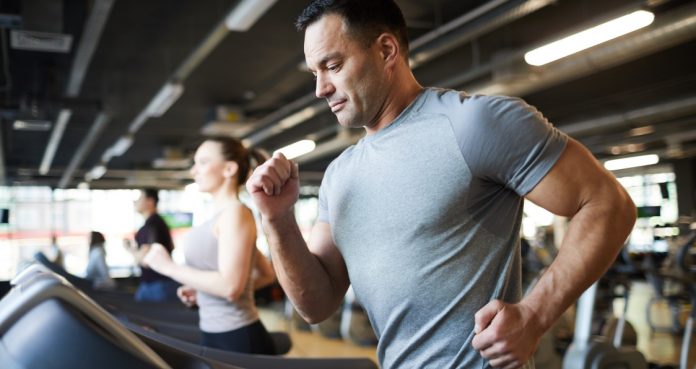
Best Cardio Methods For Bodybuilders Who Hate Running
A little bit of cardio does wonders.
We’ve heard it a million times – “I love working out I just hate running.” Since we were young running has been touted as the ultimate form of cardio. Those weekend warriors with their Nike spandex gear don’t make it any easier. With watches that track every step and instagram pictures to boot – these guys wear every mile as a badge of honor.
Well we’ve got news for those guys. While running is definitely good in moderation, too much of constantly pounding the pavement will wreck your joints especially your knees. Compounded with the massive size of most bodybuilders it’s no wonder it’s not every athlete’s cardio of choice. Well good news. We’ve got 5 five exercises just as good…nay, BETTER than running that will be right up your alley.
20 minute 10 meter sprint
We first heard about this one Men’s Health. The first thing you need to do is mark out a length of 10 meters (about 10 steps), this will be your work area. You want to cover that 10 meter distance once within one minute (too easy right?). Now you want to cover 10 meters 2x within the same amount of time. Keep going until you can complete 20 meters in one minute.
This exercise starts slow but gets turned up real fast. Don’t cheat in the beginning, trust us you’ll need the rest. Mere mortals will make it to about 13, studs will make it to 18, and Gods will make it to 20 meters in one minute. Which one are you?
Burpees
Ah this brings me back to my military days. You start off straight up, arm to sides. You then drop down and complete a full push up, you get back up into starting position and then jump high into the air with arms extended. When you land, get back down into pushup position and repeat.
Performing just 10 reps fast can rev your metabolism as much as a 30 second all out bike sprint, burning 2 calories per burpee for a 180 lb man. Aim for 10 burpees within 60 seconds.
Kettle Bell Swing
This explosive cardio exercise works the big muscles around your glutes and quads, and sends your heart into overdrive, according to research from the University of Wisconsin.
In a recent study participants burned 2o calories per minute with an average heart rate of 93% of their max, sustained over a 20 minute workout.
Next time someone invites you to go for a run, tell them you’d rather protect your joints and raise your heart rate instead.
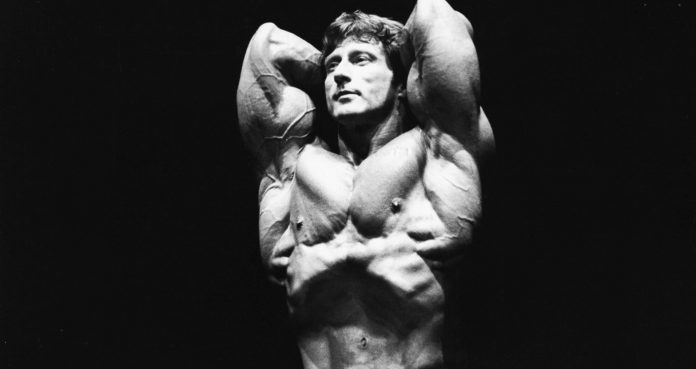
Look Like Frank Zane With These 5 Brutal Vacuum Exercises
“Here I come to save the day!”
The above quote is a catch-phrase from Mighty Mouse, a 1940’s cartoon that still has an impact to this day. The iconic character is a small mouse with big powers and an even bigger heart who… well, saves the day. So why are we writing about this on a bodybuilding site? Just as iconic as the cartoon itself, is the way Mighty Mouse was drawn, his hip to waist ratio was out of this world.
Much like many cartoon strongmen and super heroes, the over exaggerated massive chest and V-taper was truly inspiring to the concept of “mass muscle.” I remember thinking as a kid, “Can anyone have a body like that?” As builders we’re constantly striving for perfection in areas most people don’t even see. Well, we’re here to tell you that you can have that mighty mouse profile and we’ll show you how.
We know what you’re thinking, “How could I possibly have a waist like that? That’s stuff’s all genetics, I can’t change my bone structure.” Well you’re right. Barring some very painful and probably expensive surgeries you’re stuck with the hip length you have. However, it is possible to customize your workout towards attaining a more classic physique as well as getting you the classic V-shape of a Golden Era God.
The transverse muscle (TVA) is a band like muscle that runs along the sides of your midsection. It’s there to stabilize your spine and core, nature’s weightlifting belt if you will. Without a stable spine, one aided by proper contraction of the TVA, the nervous system fails to recruit the muscles in the extremities efficiently, and functional movements cannot be properly performed. The TVA and lumbar multifidus support posture and control deep breathing during power movements therefore affecting a persons cardio as well as symmetry.
Cool. Now that you know what it is how can you train it? Well, we thought that you’d never ask. Here’s the key points in learning how to vacuum your stomach.
Standing
Stand upright and place your hands on a desk (or elevated flat surface, hip height is ideal)
knees slightly bent with back humped slightly (placing weight on desk
Place your chin on your chest.
Deeply inhale and exhale sharply.
As you exhale, expand your chest and bring your stomach in as far as possible. Hold the pose but Do Not Hold Your Breath!
On your back
Lie on your back. For example while in a tanning bed or other firm surface.
Reach your arms over your head and keep your legs flat and straight.
Begin by exhaling your air.
Lift your chest and arch your back.
Draw in your stomach for seconds at a time.
Continue to try and hold your stomach in for longer and longer periods of time.
Kneeling
Begin on all fours with your shoulders vertical over your elbows and wrists, hips over your knees, and your neck in a neutral position.
Exhale, then pull your navel in as close to your spine as possible.
Weighted Dumbbell pullovers
Lie on upper back perpendicular to bench.
Flex hips slightly.
Grasp one dumbbell from behind or from side with both hands under inner plate of dumbbell.
Position dumbbell over chest with elbows slightly bent.
(Keeping elbows slightly bent throughout movement) lower dumbbell over and beyond head until upper arms are in-line with torso.
Pull dumbbell up and over chest. Repeat.
Pull down crunch
This one’s simple. Have a seat on a pull down machine and perform your best vacuum pose. Hold it while at the same time reaching up and grabbing the pull down bar. Keep your arms straight up and use your breath to slightly pull the power up and down on your inhales and exhales. Still not getting it? Check out the instructional video above.
So now that we’ve given you the building blocks to perfecting your V-shape is there anything we left out? Do you have exercises that you use to keep your symmetry on point? Let us know in the comment section below. Feel Free to respond with a picture message if you see any massive changes due to these exercises.
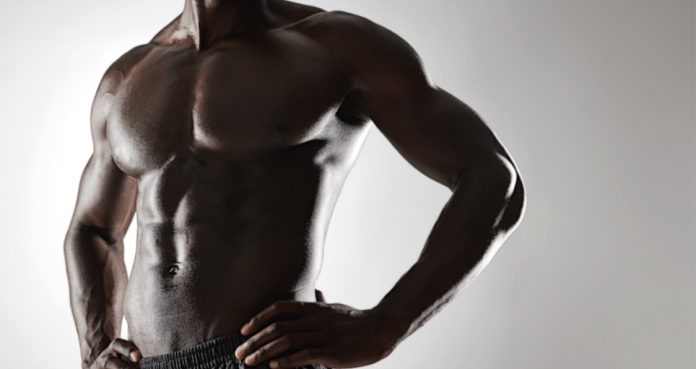
Use The Cable Pull Through For Increased Strength & Gains
Ultimate strength.
Many people out there are looking to build some great, quality muscle in order to be as shredded as their favorite superhero. It’s only natural that anyone influenced by comics and television would want to look like their favorite action hero. Think about it. There’s no doubt that when many of you first saw Predator or The Terminator with Arnold Schwarzenegger your thought process by the end of those movies was, “I want to look like that!”
There’s no shame in that at all. Every bodybuilder needs a spark that will get their engines revving. But sometimes focusing purely on aesthetics right out of the gate can end up backfiring in the long run. Building quality muscle is great, but what’s equally as important is not only building muscle that looks great, but that serve a higher purpose in your overall fitness. Building functional strength should be just as high a priority as getting ripped abs or bulging biceps.
There are plenty of ways you can build up functional strength. There are deadlifts, a perfect pull exercise, there are squats, the absolute king of all lifting exercises, but there’s perhaps one that many lifters never really consider… the cable pull through.
Sure at first glance it may seem to be some useless exercise, more like a fad than anything that can be of use for a bodybuilder or weightlifter. But in reality this movement is a truly classic exercise that many strength athletes have been using for years in order to gain increased strength. So why is the cable pull through such an effective exercise?
Stronger Posterior Chain
One reason this exercise should be in your regimen is because it gets your posterior chain in great condition. That means your hamstring, glutes, lower back, and even calves are worked by performing this exercise. It’s truly helpful in strengthening the lower body and core as well, so it can help you in other lifts.
Improved Squat and Deadlift
Speaking of improving your lifts, the cable pull through is great for giving you a stronger squat and deadlift. Because the exercise improves lower body strength as well as core strength, lifting more weight with the deadlift and squat is a given. It’s certainly a great exercise to use if you plan on hauling increased weight.
Easy to Learn
Perhaps the greatest benefit to using the cable pull through is that it’s extremely simple to learn and master. It doesn’t require too much to actually get the movement down. The form is fairly simple and because of that it’s an exercise that can be easily added to your routine.
Is the cable pull through apart of your training routine? Let us know in the comments and forums. Also, be sure to follow Generation Iron on Facebook and Twitter.
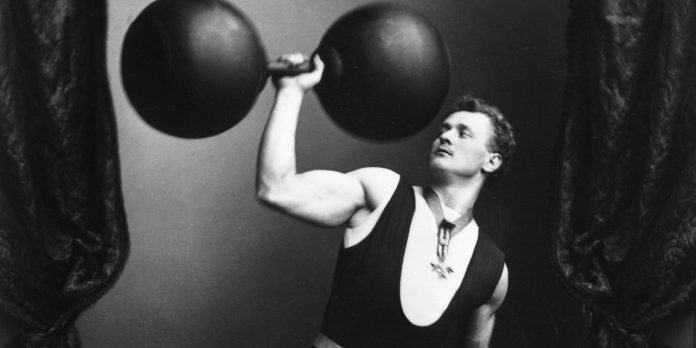
Old School Exercises You Should Be Doing
circa 1895: German strong-man Eugene Sandow (1867 – 1925) lifting weights and dumbbells. (Photo by Rischgitz/Getty Images)
Bring back these classic moves.
Bodybuilding is an endeavor that’s all about finding the perfect training routine that will give you the gains you seek. When it comes to sculpting muscle you’ll have to go through a series of trial and error in order to discover what exercises work best with your body type. Choosing to transform your body is truly a daunting task. There can be no half measures, no quick fixes. It’s all about making the necessary improvements through hard work and dedication.
To many younger bodybuilders, as well as individuals new to lifting, the notion that innovation is the key to growth is a bit misconstrued. Sure, new exercises and machines may be great in the way of accessibility and could prove to be very effective for muscle building, but that doesn’t change the fact that the classic exercises still provide some of the best results for building a strong and aesthetic physique.
All that being said, it would seem that many bodybuilders are forgetting about some of the classic exercises that provided some of the best gains ever since they were created. We’ve compiled a list of some of the greatest classic exercises that many present day bodybuilders may be neglecting, but should never forget.
Arnold Schwarzenegger: Arnold Press
A dumbbell press named after Arnold, this shoulder exercise was a great innovation during its heyday. The rotation of the dumbbells on the way up add a greater range of motion, which means attacking multiple muscle in the shoulders. This means activating more muscle fibers and growth.
Steve Reeves: Pinch-grip Deadlift
We’ve all seen the normal deadlift before, a great exercise for building up the back, but this variation can help your gains in a number of ways. This Steve Reeves derivative means grasping hold of the outward facing weighted plates, a lifting it up, barbell and all for an exercise that will work your forearms, legs, lower back, and improve your grip strength.
Dave Draper: Curl and Press
It’s hard to believe that you don’t see this move being performed in every gym across the globe. Dave Draper’s inspired exercise is basically a two in one affair. The movement is both a shoulder press and a curl all wrapped into one exercise. You get two exercises for the price of one and would work perfectly on any biceps, triceps, or shoulder days.
Eugen Sandow: Screw Press (a.k.a. Bent Press)
This one is more of a strongman lift, but nevertheless, it’s definitely an exercise you should consider adding to your routine. Why? Because functional strength is just as important to build up as much as your biceps. If you want to lift heavy then you’ll have to consider building up your overall strength. This classic made famous by Eugene Sandow himself is definitely a routine that should always be in style.
So what’s your favorite old school exercise? Let us know in the comments below and be sure to follow Generation Iron on Facebook and Twitter.
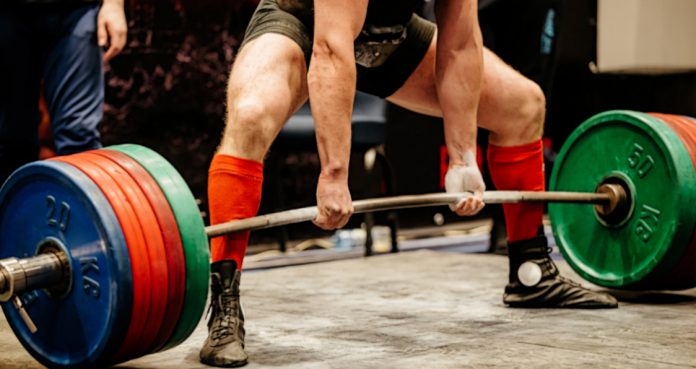
4 Reasons You Should Have Olympic Lifts In Your Bodybuilding Routine
Olympia meets Olympics.
Bodybuilding is all about hypertrophy. Building muscle is the reason for exercise after all and that means working your muscles hard until they experience hypertrophy. This, of course, promotes growth. Because a dedicated bodybuilder is going to want their entire body to be proportionate – that means working multiple muscle groups with a number of different exercises that will ensure the overall package is well defined.
But despite shaping an aesthetic physique bodybuilding does little in the way of increasing your overall strength. As an athlete, a bodybuilder should want to make improvements to more than just their physique. For that reason, adding some Olympic lifts to your routine is a great way both improve your strength as well as gain muscle.
While many people will say that Olympic lifters don’t look all that impressive physically, particularly when compared to a bodybuilder, the fact is that they possess great strength and can in fact build a great amount of muscle depending on how they train. The reason many Olympic lifters don’t have a godly physical appearance is because they’re focused on technique and improving the specific Olympic lifts. Usually they just want to get the bar up by performing either the snatch or the clean and jerk, both movements emphasizing strength, explosion, and speed. Because of this, the time they spend under tension is limited to a few seconds at best. Undergoing hypertrophy means having increased time under tension to really tax the muscle and get them to grow.
Despite that fact, you should definitely try adding the Olympic style training to your routine. But why you ask? Well, here’s a list of reasons on how you’ll see some drastic improvements.
Provides cardiovascular training
The explosive movements you must utilize in order to lift the bar from the ground during your training is much the same as sprinting. The distance of the bar movement while performing the Olympic lifts, several feet from floor to over head, means utilizing more of the body’s core mechanics, the same you’d use if you were running on a track. Compared that to lifting a dumbbell and you’ll see which requires more cardiovascular strength.
It’s a total body workout
Olympic lifts are also a great tool for getting a total body workout. You can’t just perform the snatch and clean and jerk and call it a day. Olympic style training requires you to have good fundamentals in the deadlift and the front and back squats. You’ll be training those lifts along with the Olympics lifts which will ensure your entire body is being worked.
The increased strength and explosion
This should be a no brainer. Having increased strength and explosion in your lifts will easily translate over to improvements in all your lifts. That includes bodybuilding staples like the bench, squat, and the deadlift. Training the Olympic lifts means overall performance gains.
Easy to add to a routine
The movements can easily be added to any of the routines you do in the gym. It can be added at the beginning or the end of your training session. If done correctly they can be great for crashing through a plateau or just generally improving your abilities. Try a light form at the beginning of your workout for a great warm up or at the end to thrash an already taxed body.
Do you have Olympic lifts in your routine? Let us know in the comments and forums. Be sure to follow Generation Iron on Facebook and Twitter.
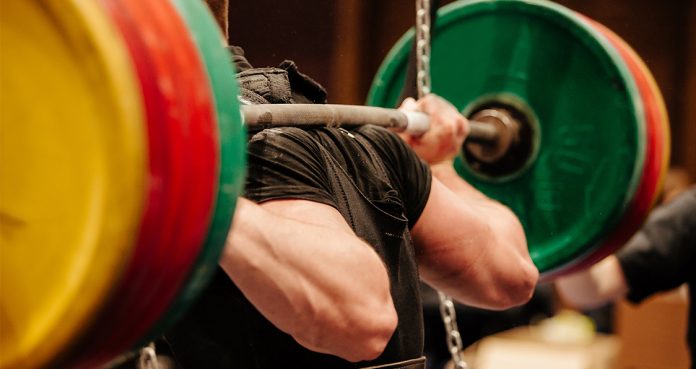
GUIDE: Become A Master Of The Squat
Why drink and drive when you can squat and fly?
The squat is one of the most natural and beautiful movements in bodybuilding. It’s also a standard position for bearing massive weight. The squat is an exercise we’ve all performed and think we’re doing right. After all there’s not much to it right? Wrong. Like all full body exercises, the squat is a movement that requires a perfect balance of many moving parts. Everything from breath to foot position should be considered before attempting this seemingly simple move. So do you want to master the squat or continue doing it half-assed like the rest of the lames at the gym? We thought so, read on.
Pre Squat
Before even attempting the squat there’s somethings you want to consider. Breathing correctly and having a straight but rigid spine will help give you stability to up your gains.
Breathing
We know it may seem monotonous and you do it without thinking anyway but being mindful of your breathing can effect not only your numbers but your life. You’d be surprise at how many times we clam up or stop breathing completely before a big task. Instead of breathing up and down try breathing in and out. Put your hand on your collar bone, if it goes up when you breath in then you’re doing it wrong. Try belly breathing, make sure your belly expands and contracts when you breathe out and in, you will physically see your rib cage going out and in when you’re doing it right.
Rigid Spine
Everyone knows you’re suppose to keep your spine straight but few people keep in mind to keep their torso rigid. This goes hand in hand with breathing, when you breathe out try and push out your obliques also. This should give you a flat stomach but visibly protruding obliques. Don’t overdo it now, it should feel fairly natural, the main thing is to make sure your center is firm and solid.
Other things to Consider
Things like lat engagement and clenching your cheeks (yes the bottom set) are also important before squatting. You can get lat engagement by simply pinching your shoulders back. The main thing to remember is that you are one solid unit, if a heavy weight was to fall on your shoulders from your standing position you should be able to bear it.
On The Bar
Now that you’ve been practicing your stance and your breathing let’s move onto the real deal stuff – the bar.
Unweighted bar
Get under the bar and get that good stance we spoke about earlier. This is where you want to work out all of your last minute kinks. So from top to bottom here’s how it goes.
Head neutral
Not to the floor, not to the sky. Find a spot where the floor meets the wall and hold your gaze.
Bend the bar
Actively pull into the bar with your two hands, this will help your posture and keep the bar tight to your body. You want your hands to be just wide enough to hold the securely behind, too lose and you won’t engage your lats.
Root your feet
You want to engage your feet but not the way you’re probably thinking. As opposed to just applying downward pressure try twisting your feet into the ground. The conscious effort to to pull your heels in will not only apply downward pressure but will pull your knees into optimal position.
At this point there’s nothing to it but to do it, or rather, the point where you’ve got to lift some heavy ass weights. We suggest you take your time and go through each of the stages we spoke about before. You’re breathing, your stance, and your on the bar last minute checklist. You’re going to notice that you’re still making some of the same mistakes but don’t be too hard on yourself, in time you will break those bad habits. We recommend you lift with a friend to make sure you’re doing all your reps correct to form. Start off small until your position becomes automatic and then start the youtube videos..
And hey – once you’ve mastered this or if you’re already a master check out the variations below to add something new to your routine.
Jump Squat
Cross your arms over your chest.
With your head up and your back straight, position your feet at shoulder width.
Keeping your back straight and chest up, squat down as you inhale until your upper thighs are parallel, or lower, to the floor.
Now pressing mainly with the ball of your feet, jump straight up in the air as high as possible, using the thighs like springs. Exhale during this portion of the movement.
When you touch the floor again, immediately squat down and jump again.
Repeat for the recommended amount of repetitions.
Kettlebell Pistol Squat
Pick up a kettlebell with two hands and hold it by the horns. Hold one leg off of the floor and squat down on the other.
Squat down by flexing the knee and sitting back with the hips, holding the kettlebell up in front of you.
Hold the bottom position for a second and then reverse the motion, driving through the heel and keeping your head and chest up.
Lower yourself again and repeat.
That about wraps it up. Follow through the guide above and you’ll be a master of the squat in no time. Make sure to hit us up in the comments with any other tips that you think makes you a master of the squat. Stay pumped.
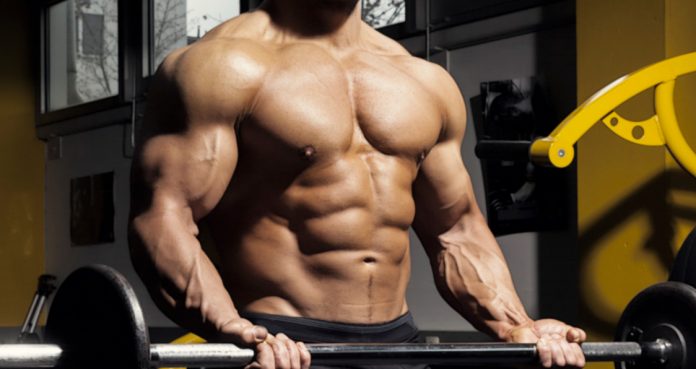
The Non-Stop Mass Building Method For Giant Size
Giant sets for giant gains.
Bodybuilding training isn’t a roller coaster of excitement. In fact, bodybuilding workouts can be completely boring, especially if you don’t have that drive for perfection. It’s one of the reasons why pro bodybuilders get so much damn respect. To train hard, day in and day out, utilizing practically the same movements over and over again can be tedious to say the least. No one said training was supposed to be an exciting experience.
Still, if you’re going to be spending your time trying to perfect and sculpt your body then you’re going to want some variations to your routine to keep things fresh. There’s nothing worse than letting things become stale, so a new program every now and then is beneficial to break up the monotony. For a true bodybuilder, the best way to make a training session more exhilarating is to ramp up the intensity..
This is where Giant Sets come in handy. Where a superset requires you to perform two exercises with no rest in between exercises and a triset requires you to perform three – a giant set ups the number to four ensuring that you’ll definitely get a pump out of the exercise. Like supersets and trisets, when performing a giant set you’re going to want to work the same muscle if not the entire muscle groups surrounding the area being worked on for the day. So if you are focusing on bicep development then you’re going to want to perform exercises that target the bicep itself or the antagonizing triceps muscle group.
Though giant sets are great for changing up your routine, it can be a bit of nightmare logistically. If your gym is filled to the brim with other avid lifters then you’re going to have a bit of a hard time trying to utilize all the machines needed for a the massive set. The idea is to pick the right opportunity to use this training method. The problem is once you perform giant sets and start seeing results you may not want to try any other program.
Back
Bent Over Barbell Row
3 sets, 8, 10, 12 reps
Lat Pull Down
3 sets, 12, 15, 20 reps
Dumbbell Row
3 sets, 8, 10, 12 reps
Pull Ups
3 sets, 10, 12, To Failure
Legs
Leg Extensions
3 sets, 12, 13, 15 reps
Leg Curl
3 sets, 12, 13, 15 reps
Stiff Legged Deadlift
3 sets, 8, 10, 12 reps
Squats
3 sets, 6, 8, 10 reps
Are giant sets apart of your routine? Let us know in the comments below and be sure to follow Generation Iron on Facebook and Twitter.
The GI Team is here to provide top news and original content for the new generation. The generation of bodybuilders who are pushing the sport to bigger and better places. Join The Movement. Become a part of Generation Iron!
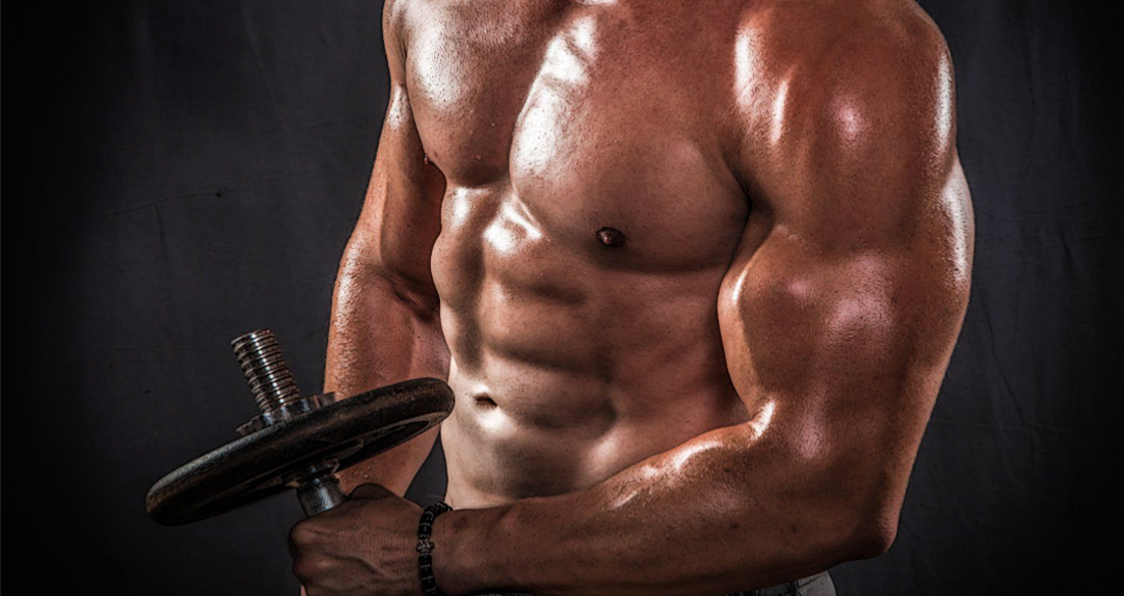
Want Major Muscle Development? Lift Fast!
Put some more speed into your lifts.
We’re always trying to find new ways to build muscle. It’s the number one reason that we hit the gym in the first place. Switching up your routine every now and then can really help your muscle building endeavors in more ways than one. Firstly, it will keep you from getting bored with your routine.
Training can become so mundane that following the same program week in and week out can prove pretty tedious on the road to gains. But most of all, it helps to avoid hitting the much feared plateau, giving you the opportunity to make your workout more challenging. Lifting speed is one method that has been proven to help and can make a big difference in your training.
When most people talk about muscle building, they’ll tell you that the key to making some major gains is to perform your lifts slowly so you can give your muscles a steady burn. While that is true, it’s not the only method that can be used to stimulate muscle growth. There have been studies that suggest lifting at faster speed can prove to give you even more gains than lifting slow. But how exactly can you benefit but performing your lifts faster? Let’s take a look.
Develop Strength (Movement Feels Lighter, You Can Use More Weight)
Lifting fast can be great for building your strength. While lifting moderate weight and lifting faster you’ll notice that the task of lifting the weight becomes easier. This is because of the momentum utilized by trying to lift faster. That same momentum, some will call cheating, will help you to lift heavier weight which in turn translate to more muscle and more strength to perform the movement. Do it enough times and eventually you’ll notice some improvements in your one rep max.
Develop Power (The Ability to Accelerate is Needed in All Sports)
Often confused with strength, the development of power has to do with two things. Power is a combination of strength and speed that allows for explosive movements. By lifting faster you improve your ability to explode into your lift. Your core strength will improve and it will translate into strength gain as well. Strength and power work in tandem together, the muscle strength and endurance allows you to last while the power allows you to push weight with more ease.
Work More Muscle Fibers (If You’re After Muscle Development: Lift Fast!)
This is perhaps the number one reason why you should be lifting fast. Faster movements activate more muscle fibers which in turn translates to greater gains. The explosive power and muscle strength from lifting work together to utilize an increased number of muscle fibers due to multiple muscle groups having to work together all at once.
Putting it simply, the explosive movement of lifting faster will help develop you fast twitch muscles which translate to a greater development of the entire muscle group that is being attacked. That means greater gains and greater muscle development.
What’s your views on fast lifting? Let us know in the comments below and be sure to follow Generation Iron on Facebook and Twitter.
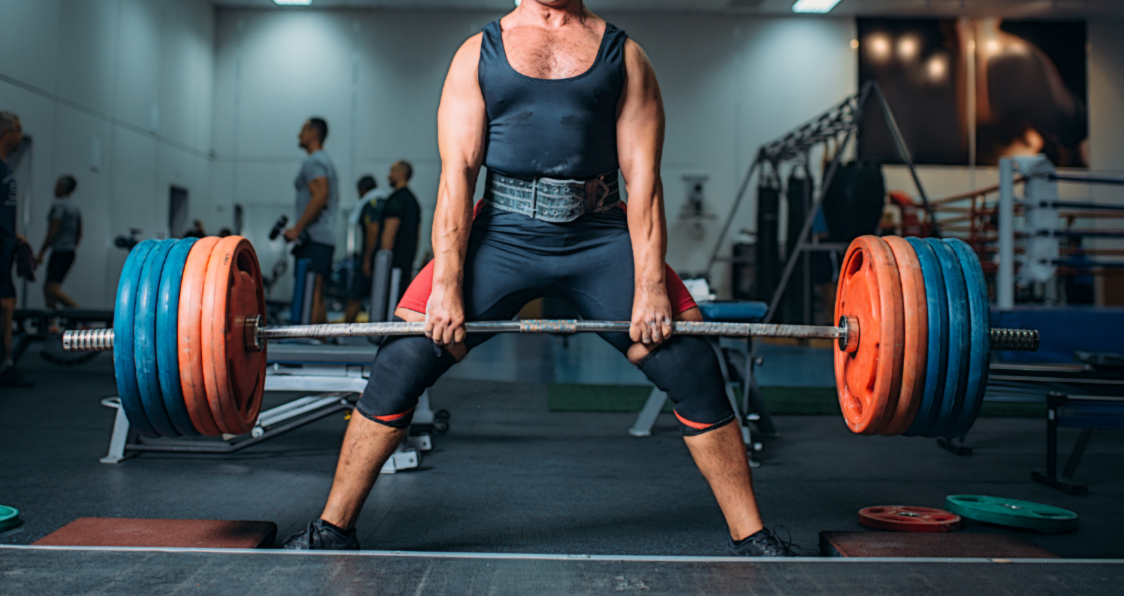
How To Deadlift Without Passing Out
Don’t fall face first into the weights.
We’ve all seen it before. Guys passing out from doing heavy deadlifts. It’s a phenomenon that has left many viewers holding their ribs in mind numbing laughter while leaving others scratching their heads. What the hell causes that to happen in the first place? Is it the mental stress of performing the lift or is there some other cause behind this strange occurrence?
When you’ve been lifting for a long time you’ll notice that guys in the gym usually tend to train the deadlift considerably less than they do the bench and the squat. At least they do when they start going heavy. The amount of stress benching and squatting puts on the body pales in comparison to how much deadlifts can take out of you. So what makes deads so different than the others?
Well for one, because of the nature of the lift, the fact that it’s a pulling exercise, the lifter is able to haul more weight than what you’d expect out of the bench and the squat. If you took a look at your own numbers you’d probably realize that your deadlift is in some cases double the amount of what you bench. It’s the reason deadlifts are trained 3 to 4 times a month as opposed to being apart of a lifters typical back routine 3 to 4 times a week.
Despite the fact that deadlifts are awesome for back gains they’ve proven to be dangerous. Here are some tips that every lifter should consider when performing this powerful exercise.
If you want to get even more in-depth, make sure to check out Generation Iron Plus for online bodybuilding courses, training guides, nutrition plans, and more. It’s the ultimate tool to become the best bodybuilder version of yourself.
1. The effect on the central nervous system
The stress that deadlifts put on the central nervous system is substantial. Performing the lift successfully can be a daunting task and be taxing both physically and mentally. You’re lifting the bar from a static position which requires the lifter to generate a substantial amount of strength. Be mindful of the amount of stress you’re putting your body under.
2. Rest Periods
Recovery is also paramount to performing this exercise consistently and frequently. Rest intervals are important to build up enough strength to perform the action again and if you rush things you can find yourself passing out from the sheer fatigue and pressure.
3. Be mentally prepared
It may seem a bit self explanatory, getting your head in the game to perform a heavy lift, but it’s essential that when you’re performing the deadlift that your mind is completely focused on the task. Where performing a back squat virtually depends on you completing the action or being crushed under the barbell’s weight, the deadlift requires you to do the lift from a static position. You’re mind forces you to complete the squat or face serious injury giving you a mental edge. When you perform the deadlift you have to approach the bar with a positive attitude and the mental fortitude to not just try and lift the bar, but know that you’ll lift it without a doubt in your mind.
The deadlift can be mentally and physically taxing, but if you have an iron will and play things smart then you’ll be performing the deadlift with ease in no time. While there is no sure fire miracle tip that will 100% prevent you from passing out – keep these three key elements in mind every time you go into the deadlift.
What are your thoughts on the deadlift? Let us know in the comments below and be sure to follow Generation Iron on Facebook and Twitter.
- 1
- 2
